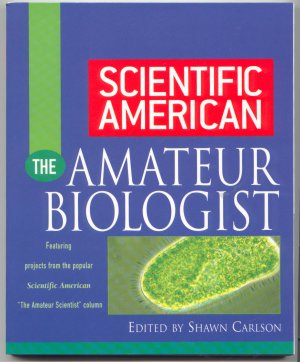The Amateur Biologist
Edited by Shawn Carlson
Publisher:
John Wiley & Sons; (2002);
ISBN: 0471382817

- Miscellaneous Techniques:
Video Microscope
Electrophoresis
Measuring Metabolism of Small Animals
High Altitude Chamber
Tin-Can Kymograph
Microscope: Subtle Secrets and Advanced Techniques - Botany:
Museum Secrets for Preserving Plants
Growing Plants in a Controlled Environment
The Essence of Hydroponics
Geotropism: The Effects of Gravity on Plant Growth
Exploring Growth Inhibitors
Experiments with Substances That Stimulate Plant Growth
The Effects of Ultrasonics on Plant Development - Cellular Biology:
The Pleasures of Pond Scum
Experiments with Animal Cells
Exploring Slime Molds
Fabulous Phototaxis - Entomology:
Lovely Lepidoptera
measuring Insect Metabolism
Getting Inside an Ant's Head
Detecting Insect Heartbeats
Learning in Sow Bugs - Microbiology:
Mouse Genetics
Fruit Fly Genetics
Spooling the Stuff of Life
Would you like to record videos of the microscopic world?
Detect an insect’s heartbeat? Separate molecules with electricity?
Extract and purify DNA . . . in your kitchen?
Now you can do all these things and more with this wonderful compendium of unique and exciting projects. Gathered here, in the most comprehensive, wide-ranging collection of projects available for the amateur biologist, are some of the finest experiments from Scientific American’s popular "Amateur Scientist" column. Whether you’d like to find out how to measure the metabolism of an insect, learn museum secrets for preserving plants, or discover how to teach a sow bug to navigate a maze, you’ll find the project to suit your needs.
Filled with experiments from a wide range of specialties, including botany, genetics, behavioral studies, cellular biology, microscopy, microbiology, and entomology, this fascinating book also contains helpful hints and clear instructions on how to build experimental apparatus using simple household materials and affordable alternatives to more expensive scientific equipment. Whether you’re a student, teacher, or dedicated amateur scientist, you’ll find projects here to excite your interest as well as deepen your understanding of–and appreciation for–the natural world.